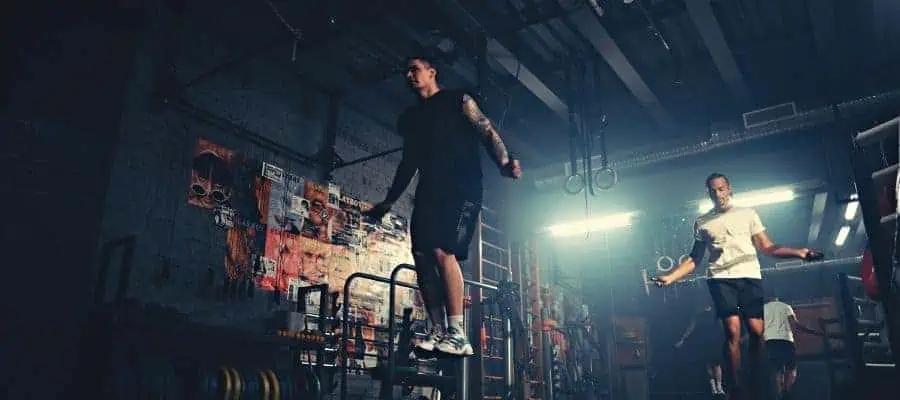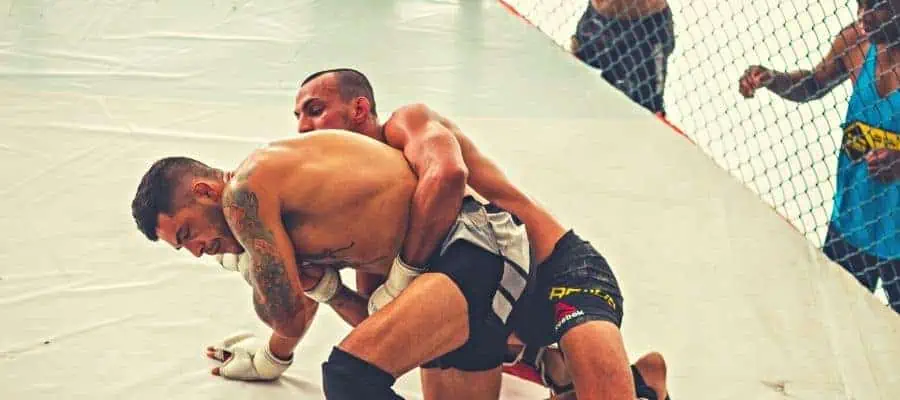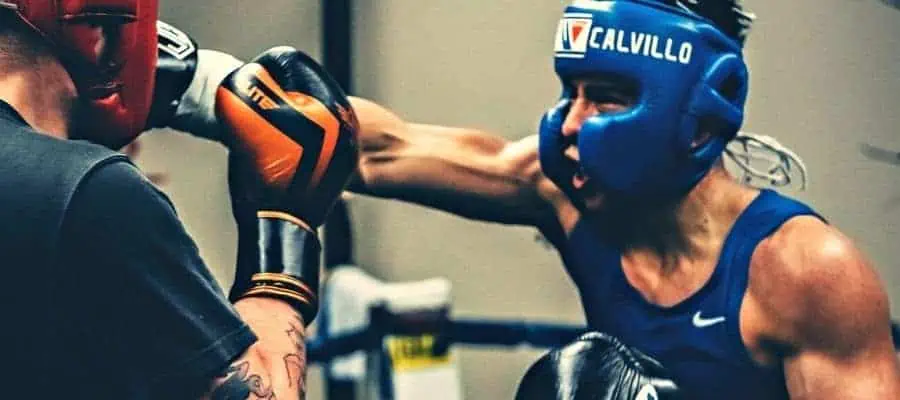Agility is the ability to get out of any situation effectively. It means the ability to handle any muscular task correctly, quickly, rationally, and resourcefully. Agility is not contained in the movement itself but is revealed only when it is affected by an external situation.
The difficulty lies exactly in finding the right way out of a suddenly changing situation quickly and in the correct way. In those situations, it is required to quickly adapt movements to such external factors, which cannot be predicted in advance. It is not uncommon to hear and read in books that agility is a purely inborn skill.
They say that you can improve your strength, endurance, and speed, but you have to be born agile. Agility is a skill that can be improved. It can be trained and exercised, but not every type of agility can be developed to the same level for every person. It is important to know that agility develops with muscle experience.
Rope Jumping

With each rotation of the rope, jump over it with both feet together. Alternately jump on your right and left foot. Bounce on one leg only. After one turn of the rope, cross your arms in front of you. Do two rope turns with each jump. Rotate the rope in the other direction, so that it goes close to your legs from the back.
And in this way make any of the jumping types described above. This exercise develops hand-to-eye and hand-to-foot coordination, timing, and endurance. Improves sparring tempo and technique combinations.
Knee Lifting

Take the starting position – fighting stance. From a fighting stance, lift the knee of your right leg to your chest and at the same time jump forward on your left leg. So you need to move your body with the help of your right knee. Continue doing the exercise, alternately jumping on your left and right leg.
The number of reps is 10-15 times. The tempo of the exercise is medium. This exercise develops coordination, balance, and agility. Also, it helps to improve the ability to move the whole body while balancing on one leg and keeping the center of gravity stable.
It is a useful exercise for practicing attacks in slips and jumps. When doing this, try to jump forward, not up. When landing, after the jump, stay balanced, making sure your foot touches the surface first with the forefoot, then the heel.
Jumping In A Fighting Stance

Take starting position – fighting stance. From a fighting stance, jump forward and, on landing, touch the floor with fingers of your right hand to the right side of yourself. After the next jump, touch the floor with the fingers of your left hand on your left side. Do the exercise at a medium tempo. The number of reps is 10-15 times.
This exercise develops the coordination of the upper and lower body, balance, agility. While doing this exercise, try to jump up and not just forward. Control your balance during the grounding. When you touch the ground, try to touch the front of your foot first, then the heel. Control your breathing after a series of jumps.
Star Jump

Start by sitting in the squat position. Jump up from the squat with your arms and legs spread out. As you touch the ground, take the starting position. Do it at a medium tempo. The number of reps is 10-15 times. This exercise develops general coordination while making unexpected and fast movements.
Also, it helps to improve coordination, agility, balance, and speed. While executing this exercise, try to jump up as high as possible. When jumping up, expand your upper body as wide as possible in flight, and be sure to group up when touching the ground.
Try to ground on the front part of your feet, then on the heel. Control your breathing after a series of jumps.
Forward Roll

Start in the squat position. From this position place your palms on the floor, press your chin to your chest and do a roll forward. The tempo is medium. The number of reps is 10-15 times. This exercise develops general body coordination. Develop the skills of falling and recovery.
Be sure to group your body while doing the rolls. Be very careful when you do it on a hard floor, to avoid injuring your body, head, and spine. Control your breathing after a series of rolls forward.
Back Roll

Start in a squatting position. From this position, raise your hands, with palms facing forward to the level of your head. Quickly put your hips down on the floor and roll backward, helping yourself with your hands. This exercise develops overall body coordination. Develops fall and recovery skills.
When performing back rolls on a hard floor, be very careful not to injure your head, neck, and spine. When doing the back rolls, be sure to group yourself. This means pressing your chin to your chest, so you don’t hit the ground with the back of your head. Control your breathing after a series of backward somersaults.
Back Roll With A Partner

The exercise is done in pairs with a partner. The starting position is squatting facing each other and pressing your palms into the palms of your partner. On signal, both of you push away from each other at the same time and do a back roll, quickly returning to the starting position. The tempo is medium.
The number of reps is 10. This exercise develops overall body coordination, balance, agility, and flexibility. When doing a back roll, be sure to group yourself, keep your chin pressed to the chest so as not to hit the floor with the back of your head.
Partners should push away from each other only with minimal effort. Control your breathing after a series of back rolls.
Bicycle Abs

Take the initial position lying on the floor on your back, lift your hips of both legs up. From this position, rotate your legs alternately as if you were riding a bicycle. The tempo is fast. Do this exercise for one or two minutes without stopping.
This exercise develops coordination of the upper and lower body, strength, and agility. Coordination of the upper and lower body is necessary for coordinated movement with punches and throws. Perform leg movements as quickly as possible for you. Keep your body in balance and control your breathing.
Alternately bring your knees up to your chest, placing your hands on the back of your head and raising your shoulders above the floor. Alternately bend and straighten your legs while touching your knees with your elbows.
Jump With Knee To The Chest

Take the starting position – the body naturally straightened, legs and feet together, hands by side. From the starting position, jump up and touch your chest with your knees. The tempo is medium. The number of reps is 8-10. It develops the coordination of the upper and lower parts of the body, strength, flexibility.
To prevent ankle injuries, make sure to land on the front parts of the feet. Bounce on an exhalation and return to the starting position on an inhalation.
Backwards Running

Take the starting position of standing with your back to the starting line. From this position run with your back to the front for a distance of fifty to a hundred meters. This exercise develops general body agility, coordination, perception, balance.
Develop defense movement skills. Exercise on a hard surface free of any obstacles, try not to fall on your back.
Side To Side Jump

Take the starting position – the body naturally straightened, legs and feet together, hands by side. From the starting position, with both feet together, jump from side to side. Do it as fast as you can. The number of reps is 10 in one set. This exercise improves mobility and the ability to control body weight.
Develops strength, coordination, and balance. Increases speed and movement mobility, as well as the ability to control the body. To avoid ankle injuries, land on the front of your feet after the jump. Use more tempo, amplitude, and several reps after developing some strength and speed.
Control your breathing after each series of jumps.
Shadow Boxing

For one or two minutes, fight against an imaginary opponent. This exercise develops general body agility, coordination, sense of timing, and stamina. Develops skills needed for sparring. While performing the exercise, combine different moves, punches, and kicks. Control your breathing.
Birch Exercise

Take the starting position of lying on your back. From the starting position, lift your legs, transferring your body weight to your upper back and shoulders. Also, put your hands on your lower back to keep your balance. Hold this position for 10-15 seconds.
This exercise develops overall body agility, flexibility, balance. Develops the skills of falling and grappling on the ground. Stop doing the exercise if you have back or neck pain. Hold a straight-leg position and try to stretch your body upward as much as possible. Breathe as naturally as possible.
The Rollover

Start by sitting on the ground with your knees together and pressed against your chest. Also, hold your arms around your legs. From the starting position, roll backward and touch the floor behind your head with your feet while your legs are straightened. The tempo should be fast. The number of reps is 10-15 times.
This exercise develops general agility of the body, flexibility. Develops the skills of falling and fighting on the ground. Stop doing the exercise if you have back or neck pain. Also, keep the balance while you are doing this exercise. Perform backward movement on exhalation, return to starting position on a breath.
One Arm Hop

Take the starting position of leaning on one arm against the floor, legs straightened backward. From the starting position, move your legs as quickly as possible around the leaning arm. Do the exercise on the right and left arm in turns. The tempo is medium. The number of reps is 5-8 times.
This exercise develops general agility of the body, strength, balance. Not recommended to do this exercise if you had any hand injuries in the past. Keep the starting position of your body during the whole exercise. Control your breathing.
Wrestling On Knees

The exercise is done in pairs with a partner. Take the initial position sitting with your back to each other, legs straight in front of you, hands by side. From the starting position, on command, turn around, taking a position on your knees.
Then, taking each other’s shoulders or arms, wrestle and try to put your partner on the ground. The loser is the one who first touches the floor with any part of the body except the knees. This exercise develops general agility, balance, speed, and strength.
Develops the ability to choose the right body position during the grappling. While wrestling tries to control your balance and your breathing.
360 Jump

Take the starting position where your body naturally straightened, legs and feet together, hands by side. From the starting position, raise your right arm and jump out and make a 360-degree spin in the air around your axis to the right. Then raise your left arm and jump with a 360-degree turn on your left axis.
Try to land at the same point from which you jumped out. The number of reps is 3-5 times. If you can easily do a 360-degree jump, try to make a turn and a half or two in the air. This exercise develops spatial perception. To avoid ankle injuries, try to land on the front of your feet while jumping.
Perform jumps on the exhalation and return to the starting position on the breathing.
Shadow Boxing With Eyes Closed

Take the starting position – fighting stance. From a fighting stance, close your eyes and execute any fighting movement (punch, block, etc.). At the same time focus on moving in the right direction. During the first workouts, you can open some times your eyes and check where do you moving.
One set is done for 10-15 seconds. Close your eyes and try to do a combination of techniques in a straight-line movement. This exercise develops spatial perception, coordination, and balance.
Body Spins

Take the starting position – your body naturally straightened out, legs closed, feet together and arms extended out to the sides. From the starting position, do ten to fifteen spins and turns around your axis, and then immediately try to walk in a straight line.
This exercise effectively develops coordination and balance. Also, it reduces the recovery time after the execution of the spinning technique. Try to exercise in an open space, free of obstacles and sharp objects. Control your body position after doing the twists.
Catch An Object With Eyes Closed

Take a natural stance, close your eyes, and try to blindly catch any object thrown upward ( for example, a tennis ball). Make as many tries as possible to catch the object. This exercise helps to develop the ability to measure distance by noise, which is necessary for fighting in a dark or poorly lighted room.
Punch Defense

The exercise is performed in pairs with a partner. Take the starting position – stand facing your partner at arm’s length. From the starting position, your partner does different attacks with his hand, and you should meet them with the proper blocks.
Start with a limited number of techniques and gradually bring the exercise to a free exchange of punches. You can use kicking, grappling, and throwing techniques according to the martial arts style you are learning.
The exercise can be done in a group, with one athlete standing in the center of the circle and the others attacking him in random order. This exercise effectively develops the ability to recognize and quickly respond to several different types of attacks with needed actions.
Jump Over The Rope

One athlete holds the belt or rope, and the second athlete stands about one meter away. The first athlete spins the rope around his axis and rotates the rope over the floor. The second jump over the rope. You have the following variations of execution:
1 Spin is done at different speeds. 2. The first athlete holds two belts, one in each hand. 3. Rotations are executed unexpectedly. 4. Rope spins at head level and the second athlete must slip under it. This exercise develops spatial perception, agility, coordination, and timing.
Also, this exercise can help to improve your reaction time while you are choosing how to dodge the rope.
Pads Work

The exercise is performed with a partner and the use of punching pads. Take the starting position where you are facing your partner in a fighting stance. From the fighting stance your partner periodically holds out a pad and your task is to punch or kick it. Here you have some execution variations:
The punching pad is placed at regular time intervals. The pas is removed after 2-5 seconds, depending on your skills level. The pad is put in different positions, depending on what type of punches you choose (straight position for the cross, side position – for a hook, and so on).
The exercise can be performed in a group. This Exercise develops the skills of target detection, timing, strength, and speed. By varying the pad’s frequency and location, you improve the ability to quickly identify a possible attack point and hit it.
Be sure to vary your punching technique and don’t forget to control your breathing.
Touch Your Opponent With Eyes Closed

The exercise is done in pairs with a partner. Take the starting position where you are facing your partner at arm’s length. One closes his eyes, and the other easily slaps him with his palm on some point of the body. The first athlete tries to touch the second one without opening his eyes.
And others in his turn, try to dodge him. The second athlete keeps touching the first at different time intervals and tries to dodge the return touch. The first stays in place for the whole exercise, and the second can move in any direction.
This exercise effectively develops tactile perception, speed, timing, and the ability to respond quickly to an opponent’s moves. This exercise is necessary for sparring and various types of wrestling.
This was a list of agility exercises and other useful skills for martial arts. I hope this article was helpful to you. Good luck.
Recent Posts
What is Manachai's Fighting Style? Unveiling Muay Thai Mastery
Manachai, a celebrated figure in the Muay Thai world, has captivated audiences with his exemplary martial prowess. Hailing from the heartlands of Thailand, his name is synonymous with the art of...
What Was Chamuekpet Hapalang's Fighting Style? Unveiling Techniques
Chamuekpet Hapalang was a renowned figure in the world of Muay Thai (record 200-48-2), embodying a fusion of Muay Bouk and Muay Khao styles. Originating from Thailand, the art of Muay Thai is known...
